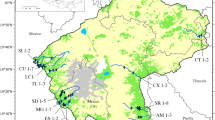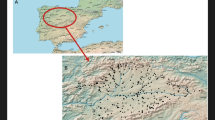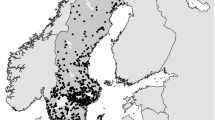Abstract
Various diatom indices are routinely used in European countries to monitor water quality in waterways. In order to assess their sensitivities and their integration interval after a sudden and lasting environmental change, epilithic diatom biofilms were transferred from several polluted rivers to an unpolluted stream. To monitor the changes of the index values, the biofilms were sampled in a first experiment 20 and 40 days after transfer, and in a second experiment 30 and 60 days after transfer. Sensitivities of the indices to the water quality improvement were assessed calculating the differences between the index values of the reference and the transferred assemblages. Some indices have intermediate sensitivities (BDI, GDI, ILM, SLA), others higher sensitivities (CEE, EPI, ROT, SPI, TDI). The integration interval of these indices was 40–60 days. Some differences were observed between the indices, but their results were homogeneous when compared to those obtained with other metrics such as Bray-Curtis or Chord distances, used to assess the difference between the transferred and the reference diatom assemblages. These other metrics showed that even after 60 days, the transferred assemblages still differed from the reference. This underlines that metrics do not have the same integration intervals and do not assess the same stresses; the choice of the metric used to assess water quality is of prime importance.
Similar content being viewed by others
Abbreviations
- BDI:
-
Biological Diatom Index
- CEE:
-
European index
- EPI:
-
Eutrophication Pollution Index using diatoms
- GDI:
-
Generic Diatom Index
- ILM:
-
Index of Leclercq & Maquet
- ROT:
-
Rott saprobic index
- SHE:
-
Schiefele & Schreiner index
- SLA:
-
Sládeček index
- SPI:
-
Specific Polluosensitivity Index
- TDI:
-
Trophic Diatom Index
References
AFNOR (2000) Norme Française NF T 90-354. Détermination de l’Indice Biologique Diatomées (IBD). Juin 2000, Association Française de Normalisation, Paris, France.
Antoine SE, Benson-Evans K (1985) Colonisation rates of benthic algae on four different rock substrata in the River Ithon, Mid Wales, U.K. Limnologica 16: 307–313.
APHA (1995) Standard methods for examination of water and wastewater. 19th ed., American Public Health Association, Washington, USA.
Barton DR (1996) The use of percent model affinity to assess the effects of agriculture on benthic invertebrate communities in headwater streams of southern Ontario, Canada. Freshwater Biol. 36: 397–410.
Bray JR, Curtis JT (1957) An ordination of upland forest communities of Southern Wisconsin. Ecol. Monogr. 27: 325–349.
Cemagref (1982) Etude des Méthodes Biologiques d’Appréciation Quantitative de la Qualité des Eaux. Rapport Q.E. Lyon, Agence de l’Eau Rhône-Méditerranée-Corse – Cemagref, Lyon, France.
Coste M (1989) Diagnostic biologique de la qualité des eaux continentales : Les principales méthodes microfloristiques. Document de travail, Cemagref Bordeaux, France.
Dell’Uomo A (2004) L’indice diatomico di eutrofizzazione/polluzione (EPI-D) nel monitoraggio delle acque correnti. Linee guida. Agenzia per la protezione dell’ambiente e per i servizi tecnici, Roma, Italy.
Descy JP, Coste M (1991) A test of methods for assessing water quality based on diatoms. Verh. int. Verein. Limnol. 24: 2112–2116.
Dokulil MT, Schmidt R, Kofler S (1997) Benthic diatom assemblages as indicators of water quality in an urban floodwater impoundment, Neue Donau, Vienna, Austria. Nova Hedwigia 65: 273–283.
Eulin A, Le Cohu R (1998) Epilithic diatom communities during the colonization of artificial substrates in the River Garonne (France). Comparison with natural communities. Arch. Hydrobiol. 143: 79–106.
European Parliament & The Council of the European Union (2000) Directive 2000/60/EC of the European Parliament and of the Council establishing a framework for the Community action in the field of water policy. Official J. Eur. Communities 327:1–72.
Gomà J, Ortiz R, Cambra J, Ector L (2004) Mediterranean rivers water quality evaluation using epilithic diatoms as bioindicators. Vie Milieu 53: 81–90.
Hoagland KD, Roemer SC, Rosowski JR (1982) Colonization and community structure of two periphyton assemblages, with emphasis on the diatoms (Bacillariophyceae). Am. J. Bot. 69: 188–213.
Iserentant R, Blancke D (1986) A transplantation experiment in running water to measure the response rate of diatoms to changes in water quality. In Ricard M (ed), Proceedings of the 8th Diatom symposium, Koeltz Scientific Books, Königstein, pp. 347–354.
Ivorra N (2000) Metal induced succession in benthic diatom consortia. Ph.D. Thesis, Universiteit van Amsterdam, The Netherlands.
Kelly MG, Penny CJ, Whitton BA (1995) Comparative performance of benthic diatom indices used to assess river water quality. Hydrobiologia 302: 179–188.
Kelly MG, Whitton BA (1995) The Trophic Diatom Index: A new index for monitoring eutrophication in rivers. J. Appl. Phycol. 7: 433–444.
Krammer K, Lange-Bertalot H (1986–1991) Bacillariophyceae 1. Teil: Naviculaceae; 2. Teil: Bacillariaceae, Epithemiaceae, Surirellaceae; 3. Teil: Centrales, Fragilariaceae, Eunotiaceae; 4. Teil: Achnanthaceae. Kritische Ergänzungen zu Navicula (Lineolatae) und Gomphonema. In Ettl H, Gärtner G, Gerloff J, Heynig H, Mollenhauer D (eds), Süsswasserflora von Mitteleuropa. Gustav Fischer Verlag, Stuttgart, Germany.
Leclercq L, Maquet B (1987) Deux nouveaux indices chimique et diatomique de qualité d’eau courante. Application au Samson et à ses affluents (Bassin de la Meuse Belge). Comparaison avec d’autres indices chimiques, biocénotiques et diatomiques. Institut Royal des Sciences Naturelles de Belgique. Document de Travail n° 38, Brussels, Belgium.
Lecointe C, Coste M, Prygiel J (1993) “OMNIDIA”: software for taxonomy, calculation of diatom indices and inventories management. Hydrobiologia 269/270: 509–513.
Lenoir A, Coste M (1996) Development of a practical diatom index of overall water quality applicable to the French national water Board network. In Whitton BA, Rott E (eds), Use of Algae for Monitoring Rivers II, Studia Student G.m.b.H, Innsbruck, pp. 29–43.
Novak MA, Bode RW (1992) Percent model affinity. A new measure of macroinvertebrate community composition. J.N. Am. Benthol. Soc. 11: 80–85.
Oemke MP, Burton TM (1986) Diatom colonization dynamics in a lotic system. Hydrobiologia 139: 153–166.
Orloci L (1967) An agglomerative method for classification of plant communities. J. Ecol. 55: 193–206.
Prygiel J, Whitton BA, Bukowska J (eds) (1999) Use of Algae for Monitoring Rivers III, Agence de l’Eau Artois-Picardie, Douai, France.
Rimet F, Ector L, Cauchie HM, Hoffmann L (2004) Regional distribution of diatom assemblages in the headwater streams of Luxembourg. Hydrobiologia 520: 105–117.
Rott E (1991) Methodological aspects and perspectives in the use of periphyton for monitoring and protecting rivers. In Whitton BA, Rott E, Friedrich G (eds), Use of Algae for Monitoring Rivers, Institut für Botanik, Universität Innsbruck, Innsbruck, pp. 9–16.
Rott E, Hofmann G, Pall K, Pfister P, Pipp E (1997) Indikationslisten für Aufwuchsalgen in österreichischen Fliessgewässern. Teil 1: Saprobielle Indikation. Bundesministerium für Land- und Forstwirtschaft, Wasserwirtschaftskataster, Wien, Austria.
Rott E, Pipp E, Pfister P (2003) Diatom methods developed for river quality assessment in Austria and a cross-check against numerical trophic indication methods used in Europe. Algol. Stud. 110: 91–115.
Rumeau A, Coste M (1988) Initiation à la systématique des diatomées d’eau douce. Bull. Fr. Pêche Piscic. 309: 1–69.
Sabater S (2000) Diatom communities as indicators of environmental stress in the Guadiamar River, S-W. Spain, following a major mine tailings spill. J. Appl. Phycol. 12: 113–124.
Schiefele S, Schreiner C (1991) Use of diatoms for monitoring nutrient enrichment, acidification and impact of salt in rivers in Germany and Austria. In Whitton BA, Rott E, Friedrich G (eds), Use of Algae for Monitoring Rivers. Studia Student G.m.b.H., Innsbruck, pp. 103–110.
Sládeçek V (1986) Diatoms as indicators of organic pollution. Acta Hydrochim. Hydrobiol. 14: 555–566.
Stevenson RJ, Pan Y (1999) Assessing environmental conditions in rivers and streams with diatoms. In Stoermer EF, Smol JP (eds), The diatoms: Application for the environmental and earth sciences, Cambridge University Press, Cambridge, pp.11–40.
Tolcach ER, Gómez N (2002) The effect of translocation of microbenthic communities in a polluted lowland stream. Verh. Int. Ver. Limnol. 28: 1–5.
Author information
Authors and Affiliations
Corresponding author
Rights and permissions
About this article
Cite this article
Rimet, F., Cauchie, HM., Hoffmann, L. et al. Response of diatom indices to simulated water quality improvements in a river. J Appl Phycol 17, 119–128 (2005). https://doi.org/10.1007/s10811-005-4801-7
Received:
Revised:
Accepted:
Issue Date:
DOI: https://doi.org/10.1007/s10811-005-4801-7




